In a recent video from LinkedIn Learning, photographer Justin Resnick addressed exposure issues which photographers can encounter when photographing snow. In this post, I’m going to address a related issue I’ve grappled with the last two winters, namely photographing while it is ACTIVELY snowing.
Living in Southern California, this isn’t a situation I’ve dealt with much. Last winter, we finally made it to snowy Hokkaido, Japan’s northernmost island, where we encountered heavy, constant snow during our one morning shooting Japanese cranes.
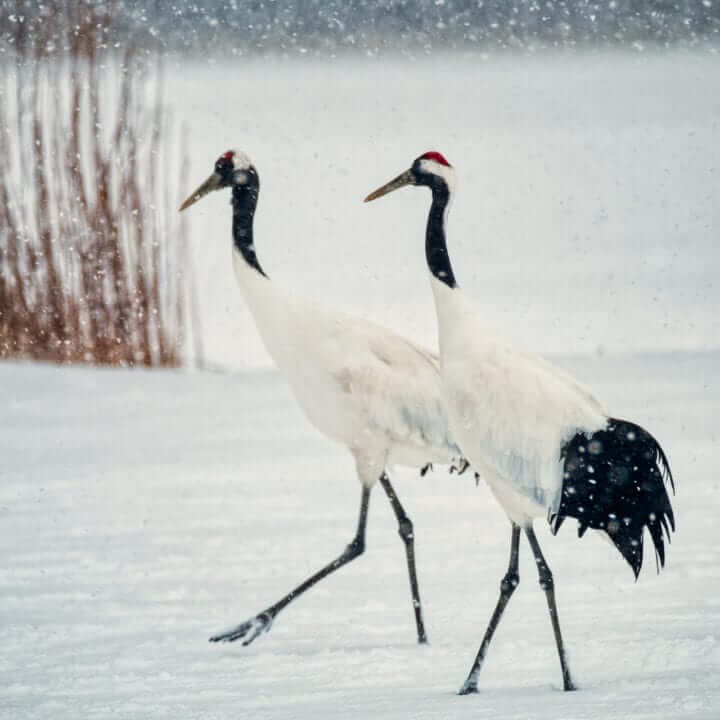
A challenging scene
This was a difficult shoot. My position was behind a fence that limited opportunities to shift position. I was in heavy snowfall. The cranes were quite a long distance away. I used my Fujifilm X-T2 with the XF 100-400mm f/4.5-5.6 R LM OIS WR lens plus a 1.4x teleconverter.
Depending on the distance of the snowflakes from your lens or the subject, the apparent size of the flakes and position in your frame can be problematic (an issue analogous to backscatter, for those underwater photographers out there). Over the white snow, the flakes blend in. In the plane of the grasses in the background, the snowflakes are small and uniform in size.
But in front of the plane of the red-crowned Japanese cranes, the snowflakes are blurry and distracting overlying the black necks and tail feathers of the birds. It would require considerable post-processing to eliminate these blurry flakes.
Two more snowscapes
Earlier this year, we happened to be in New York during a flash snowstorm, which transformed Central Park in a matter of hours from fall into a white winter wonderland (and was gone again almost as quickly hours later).
Finally, we just returned from Antarctica where a beautiful sunny and foggy morning quietly sieged into a steady silent snowfall.
Avoiding damaging moisture on the camera and lens
These situations favor using weather-resistant camera bodies and lenses. They are better sealed and built to resist some moisture.
In light snow or rain, I find camera covers more trouble than they are helpful. I keep a 3M detailing cloth handy and mop up moisture as it accumulates. I learned this from photographic workshop leader Jack Graham, who swears by this product as the best lint free and scratch resistant product out there.
There are camera covers designed for shooting in wetter weather. My personal experience in Japan is that these can be a struggle to implement in the field. Many people improvise, using a shower cap. I keep a few inexpensive options in my camera bag, such as Op/Tech’s Rainsleeve. It’s small and light.
Dealing with snowmelt on the lens
To start with, I’d choose a lens with a deep hood, which goes a long way toward keeping the front element clear. In both Japan and Antarctica, I was using Fujifilm cameras (X-T2 in Japan and X-T3 more recently) with the 100-400mm lens, which has a long, deep hood. It rarely gets snow spots under such conditions.
A simple maneuver is simply to keep the lens pointed down when you are not actively shooting. This occurs naturally using a cross-body strap, which I find essential to shooting. It’s like a third hand. I use a BlackRapid strap.
Another option to keep both the camera dry and the front lens element clear is to shoot under an umbrella. So far, I’ve only tried this with a hand-held smaller rig in Central Park (Fujifilm X100F paired with a W CL-X100 II wide conversion lens). With a smallish camera in my right hand and the umbrella in my left, this is doable in a pinch.
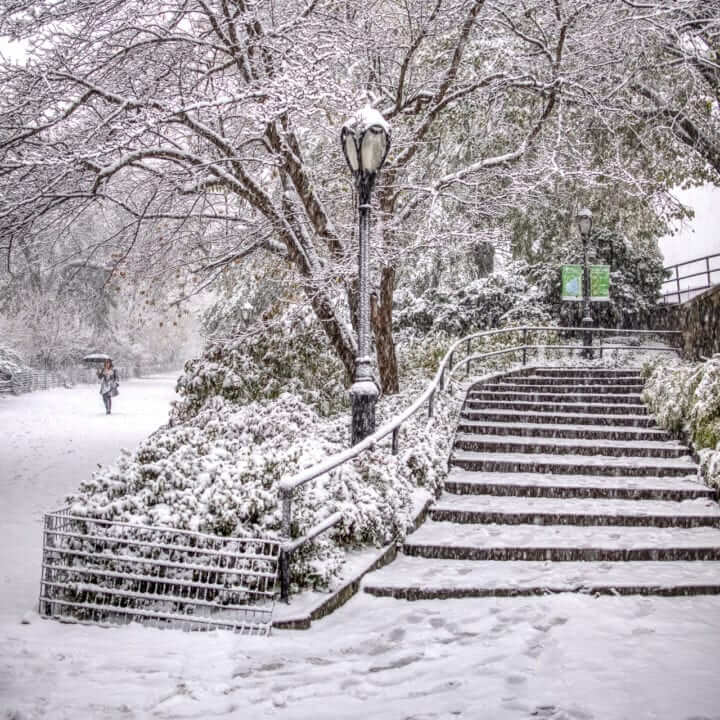
Handling an umbrella with a tripod and a camera bag looks awkward and difficult to me, so I’ve never tried it, but that’s an option. Orca makes umbrellas designed to be paired with a tripod which would be useful to free up a hand.
Shutter speeds for falling snow
The two basic choices are either to freeze the snow using a fast shutter speed or to accentuate it using a slow shutter speed, turning the snow into streaks. When the snow is steady, I haven’t always been happy with the resulting snow blobs using a fast shutter speed. Depending on where in the frame the snow blobs end up, the results may or may not be pleasing.
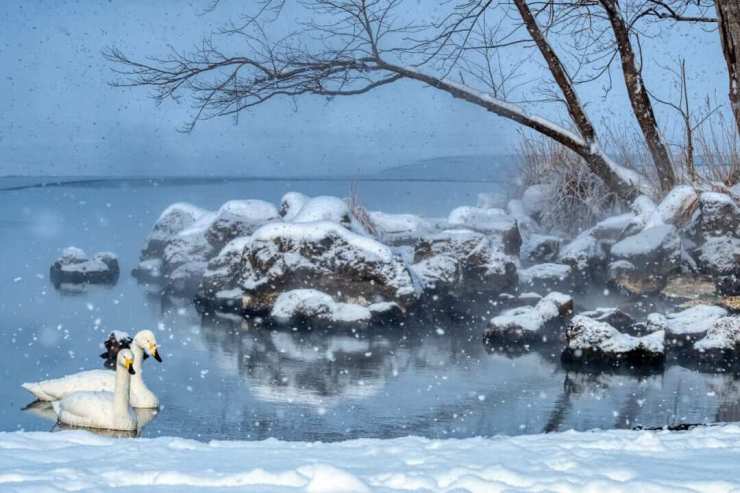
Fast speeds for snow
Above, I used a fast shutter speed (1/500s) during a steady light snowfall. Most of the snowflakes add to the scene. However, above the swans, there are two larger blurry white blobs, presumably out of focus snowflakes closer to me and the lens than the subject. Another snowflake is inconveniently positioned over the rear Whooper swan’s beak. These aren’t fatal flaws and wouldn’t be too difficult to fix in post.

Zooming in on the swans immediately after the above scene shows how variable the size and density of snowflakes will be when captured using a fast shutter speed.
Slower shutter speeds blur the snow
Conversely, getting a slow enough shutter speed to produce long enough streaks to be pleasing can be tricky and may require the use of a neutral density filter, another piece of glass that’s hard to handle in falling snow without spotting.

For this version, I used a smaller aperture (f/18) in order to have a longer shutter speed (1/30s) hoping to turn the snow into streaks. Notice the variable thickness of the streaks, due to their different distances from the camera.
On our recent trip to Antarctica, I played with both ways, recalling my experience in Japan the prior winter.
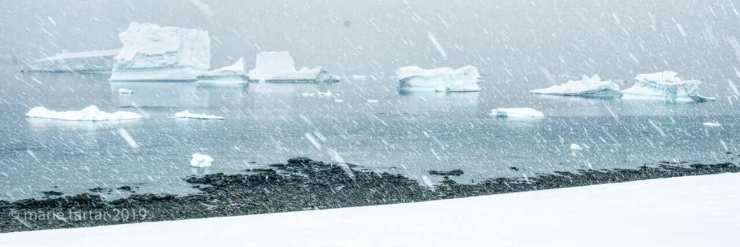
I used the slowest shutter speed I could achieve without using a filter to turn the falling snow into snow streaks The closer the distance of the snowflakes to the camera, the thicker the snow streaks appear.
Finally, I took this even a step further, carefully digging out my Breakthrough Filters 3-stop neutral density filter from my bag on the snow, keeping it vertical once out of the box, shielding it as well as I could from the wind, in order to turn the snow into a more ethereal, ukiyo-e woodblock print version reminiscent of Hokusai, seen below and in the feature image.
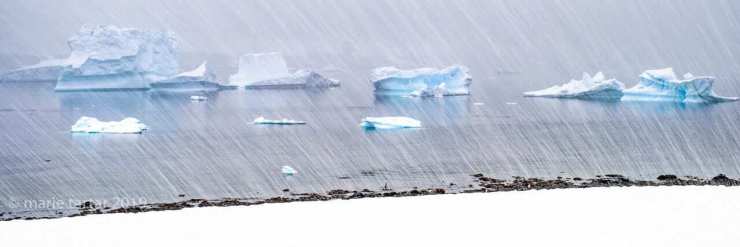
Tell your story with the second annual Visual Storytelling Conference!
Experience four days of interactive, online training sessions featuring a range of educational content with experienced photographers and content creators. This free event kicks off with a series of technical boot camps to build essential skills, followed by live, online sessions on photography, video, business and social media. Join live from March 10-13, 2022!
